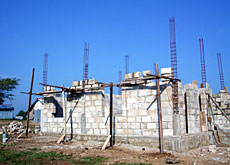
Post-tsunami rebuilding gathers pace

Swiss charities are heavily involved building homes on Sri Lanka's tsunami-hit eastern coast, with the first houses scheduled to be ready by the end of the year.
Critics say that progress is too slow, but the non-governmental organisations counter that the process has been dogged by administration and ethnic problems and that doing the job properly simply takes time.
The east coast has already suffered 20 years of ethnic conflict between the governing Buddhist Sinhalese and the mainly Hindu Liberation Tigers of Tamil Eelam (LTTE), who want an independent state.
The tsunami caused the loss of thousands of lives and widespread destruction in the area, which is divided between the two sides.
Almost a year on, the survivors are living in temporary shelters in transit camps. Most are hoping to move into their new houses by next year.
Catholic charity Caritas plans to build 676 permanent houses in eight villages in the Trincomalee region. But government approval is still pending in some areas.
Long process
Reconstruction is a long process, says Caritas coordinator Bettina Iseli. It involves drawing up lists of beneficiaries, as well as finding land and clearing up ownership issues as many deeds were washed away. Surveys and plans are needed before final government approval is granted.
“This is a situation that no one before has experienced, including the authorities,” Iseli told swissinfo. “For many NGOs it is a learning process and time intensive.”
Given the tense ethnic situation, NGOs have to tread carefully and show neutrality when negotiating between the two sides. Caritas has to contend with tensions between the Tamils and the small Muslim community in its area.
Another problem is finding good quality house materials, especially as high demand has pushed prices up.
Caritas has decided to make its own concrete house blocks. Around 400 units are produced a day at its building yard – 1,600 are needed to make a house. Local people are employed to carry out the work.
Materials are also an issue at Swiss projects further down the coast at Batticaloa. Aid agency Helvetas aims to build 130 houses in the area, of which the first 42 are expected to be ready by December 26 – the first tsunami anniversary.
The NGO explained that prices had gone up by 30 per cent in the past few months.
Pressure
Project head Karl Gerner said that there was a lot of pressure on NGOs to speed up, but he stressed it was important to do the rebuilding properly.
“Others quickly built prefab houses, then the rainy season came and the foundations were not high enough,” he said.
“Quality takes time, you need drainage, roads and then you can build houses.”
The charities have to follow government regulations, such as houses being a minimum size of 50 square metres. Around Trincomalee, the Tamil Tigers have also set rules for wall heights.
The NGOs stressed that the beneficiaries were also being closely consulted over the rebuilding.
At the Swiss Red Cross project at Nasivanthivu, where 40 houses should be ready by the end of the year, construction delegate René Schärer has already had to change his designs.
Villagers told him that the kitchen had to be outside the house. And they didn’t want an open area inside because animals would come in.
It was a similar story at Helvetas, which took into account Tamil Hindu traditions, such as the door facing east.
Happy
Most of the beneficiaries swissinfo spoke to were happy with the NGOs’ construction efforts and the plans for their new houses. These are partly financed with a grant of $2,500 (SFr3,300) from the government for those who are relocated outside the buffer zone.
As an average house can cost $6,000-$11,000 depending on its location, the charities pick up the shortfall.
For many people, from fishing or farming families, the Swiss quality housing – which is built to withstand cyclones as well as tsunamis – is a step up from what they had before.
But some voiced concerns that some of the planned new villages were too far from the sea for fishermen.
This is because of a government-imposed buffer zone preventing rebuilding close the coast.
Most NGOs, while satisfied with the results so far, remained conscious of the work ahead.
“We do our best – it’s a big job,” said Karl Gerner.
swissinfo, Isobel Leybold-Johnson in eastern Sri Lanka
The tsunami hit Sri Lanka on December 26, 2004.
More than 30,000 died and around 500,000 were left homeless.
After providing emergency aid and temporary shelters, charities are now in the rebuilding phase.
The aim is to provide houses and other infrastructure by the end of next year.

In compliance with the JTI standards
More: SWI swissinfo.ch certified by the Journalism Trust Initiative
































You can find an overview of ongoing debates with our journalists here . Please join us!
If you want to start a conversation about a topic raised in this article or want to report factual errors, email us at english@swissinfo.ch.